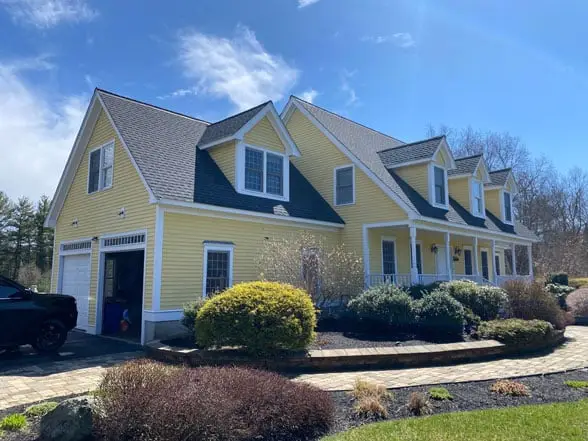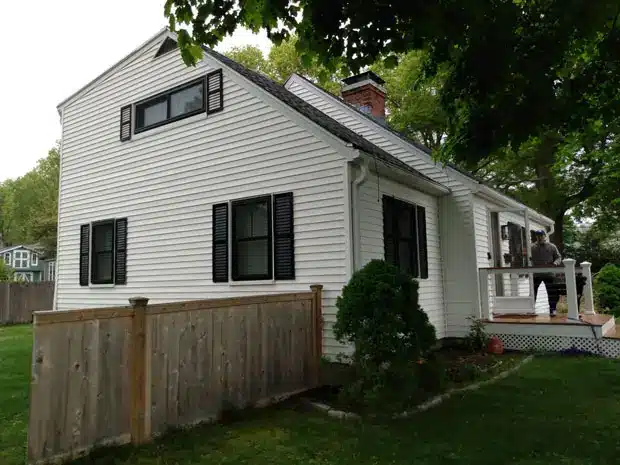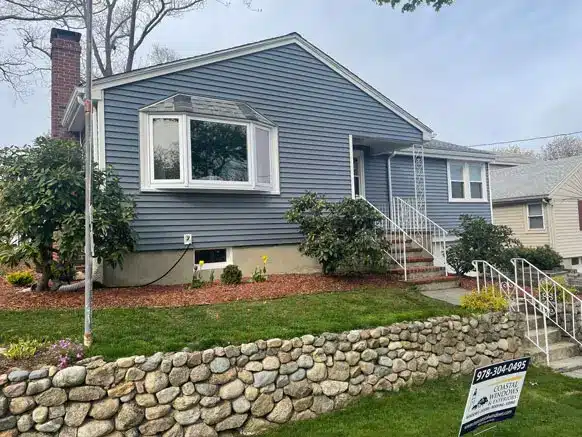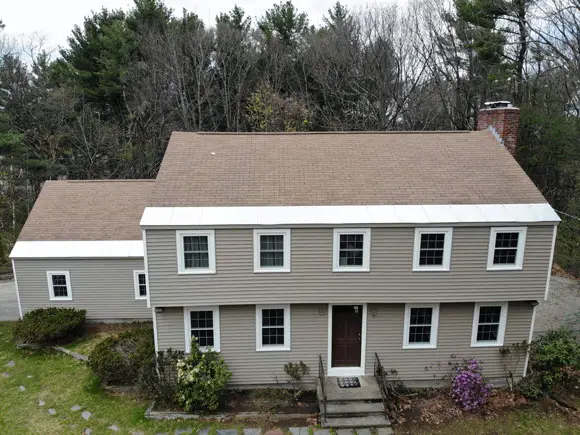If you’re seeking information on remodeling questions and answers for your exterior remodeling project, you’re at the right place. Working with countless homeowners just like you, we hear countless questions about warranties, energy savings, and more.
These remodeling questions and answers cover common inquiries about roofing, replacement windows, and vinyl siding.

Remodeling Questions & Answers: Roofing
Below, we will review some of the most common roofing questions from New England homeowners. These questions cover warranty information, pricing, and some of the roof installation processes. If you don’t see your question answered here, be sure to contact us for help!
Can My New Roof Handle High Winds?
According to the Federal Emergency Management Agency, the roof is the most vulnerable component of the home when it comes to wind.
If asphalt roofing is not installed correctly, high winds can easily peel the shingles right off of the roof. Given enough force, it can also destroy the additional layers of the roof.
To ensure that your new roof can handle high winds, check that there is a wind warranty included with your investment.
For example, a good wind warranty will guarantee that the roof can withstand Category 5 hurricane force winds, which measures up to 130 miles per hour. But the best wind warranty comes from GAF Roofing’s unlimited wind speed warranty. No matter how strong the winds are, your shingles are guaranteed to stay in place!
Will You Remove My Old Roof?
There are several ways to install a new roof. One is by installing the new roof over existing shingles, and the other way is to completely remove the old shingles and start from scratch.
Installing new shingles over the original is one of the oldest tricks in the book to cut corners. It’s an especially bad idea if there are already two layers of existing shingles on your roof. Many building codes only allow two layers of shingles on the home.
If roofing installers leave the old shingles in place, there is no way to determine if there are soft spots beneath them. Soft spots indicate a problem with the sheathing and the shingles must be removed to address the problem.
The correct way to install a new roof is by removing the old shingles. The roofing company should also remove the flashing since this product is designed to fit with the original roof.
What Impacts the Price of My Roof?
Knowing the variables of what impacts the pricing of a roof can save you hundreds if not thousands of dollars.
Variations range from roofing material to the architecture to your home. These include aspects such as:
- Roof size
- Pitch (steep roofs take a lot more time and materials to cover than a flat roof).
- Type of application (how it’s installed on your roof deck).
- Materials used. Asphalt is one of the most affordable options while slate roofing is among the most expensive.
- The number of layers (the price can involve taking off old layers, which takes more time).
- Where you live (material prices and requirements by roofers vary by region).
- Code requirements for your roof.
- The size of your home.
- If you have a lot of skylights, chimneys, plumbing pipes or other adornments that need to be addressed during the installation.
Remodeling Questions & Answers: Replacement Windows
Do you have remodeling questions and answers for replacement windows? Here’s a great place to start. These are three key remodeling questions and answers that homeowners ask about window replacement.

These questions cover energy-saving technologies, determining window quality, and learning how many windows to replace at once.
What Makes Vinyl Windows Energy Efficient?
Vinyl windows can help homeowners save tremendous amounts of energy. However, this depends on the components of those windows and the technologies used for efficiency.
Manufacturers make energy-efficient vinyl windows from several components, including:
- Argon or krypton gases: Manufacturers fill the window panes with these odorless and colorless gases. Without them, they fill the panes with air, which provides no insulation.
- Low-e application: Manufacturers apply this invisible energy-saving element to the glass pane. It reflects the sun’s rays in the summer, keeping your home cool. In the winter, it allows the sun to enter your home and naturally warm it.
- Insulated frames: Manufacturers design vinyl window frames with empty chambers unless they fill them with foam for an extra layer of insulation.
- Professional window installation: Professional installers should install windows to ensure a custom fit to the frame. Keeping a 1/8th” gap helps reduce drafts and keeps the window performing properly.
Do I Need to Replace All Windows at Once?
Sometimes homeowners will ask if they can just replace a couple of windows at a time. This might be due to time or budget restraints (we offer fantastic financing!).
If you’re paying with cash and have a strict budget to adhere to, you are able to split your window replacement project into separate phases.
However, keep in mind that this process might disqualify you from specific promotions at a later date, leaving you paying less for some of your windows and more for others. The good news is that you might be able to take advantage of a few great promotions during different times of the year!
When you must split up your time between projects, it’s best to replace the windows in the areas where you spend the most time in your home, such as your living area or your kitchen. This will help keep these areas more comfortable.
Another approach is to replace the windows in the upstairs area of your home first. This is especially the case if you are living with an older furnace, which can be a significant source of your high energy bills when combined with old windows.
Old furnaces create a natural draft where energy is lost through the windows upstairs, due to heat rising in your home. When we replace the upstairs windows in your home, you sleep more comfortably and enjoy better sound reduction.
However, if you’re open to financing or you’re able to afford the cash option, replace all of your windows at one time. This allows you to experience the full impact of new window replacement throughout your entire home.
How Do I Know That I’m Getting A High-Quality Window?
Did you know that high-quality vinyl windows yield an average return on investment of 81%? This is even higher than the national average of 75%! Not all windows perform equally, but you can ensure you get the very best quality and value for your investment by following these steps.
We first like to warn homeowners of the infamous “Beauty Queen” window. This is a window that meets the minimum testing requirements for the American Architectural Manufacturers Association (AAMA) and leaves it at that.The AAMA offers a second level, known as the AAMA Gold Label. The Fenestration Rating Council or AAMA pulls this product to ensure it matches the ratings you’ll find in the product’s brochure.
Best quality:
The idea behind Beauty Queen windows is that it looks good on paper, but it’s not necessarily the best quality. The reality is that not all of these products are manufactured in the exact same way and the industry isn’t heavily regulated.
Every window company is responsible for showing homeowners that they are withholding industry standards, or even exceeding them as we do at Coastal Windows & Exteriors.
The AAMA Gold Label ensures that you’re getting exactly what you pay for with your new window replacement. The best quality windows are engineered with 100% virgin vinyl to prevent warping, peeling, and flaking from moisture damage. They also include insulated glass packages with argon or krypton gas, which helps your home stay warm in the winter and cool in the summer.
You’ll also want to consider the window’s air infiltration rating, which is one of the keys to energy conservation. For example, our replacement windows have a CFM rating of .01 which is 23 times more airtight than the industry average.
Best of all, you won’t have to worry about all of the headaches and hassles that come along with wood windows, including constant maintenance and wood rot.
Remodeling Questions & Answers: Vinyl Siding
New vinyl siding installation is a big investment that brings an incredible facelift to your exterior. These are some of the most common remodeling questions and answers on vinyl siding, including choosing the best material and maintenance requirements.

Why Should I Choose Vinyl Over Other Siding Materials?
It’s no secret that vinyl siding is the superior cladding option for New England homes. But what makes this material the best over other siding options?
Vinyl vs. Wood
According to Angie’s List, vinyl siding is one of the most cost-effective exterior options on the market—especially in comparison to wood. Homeowners can save between $2-to-$3 per square foot on vinyl siding vs wood counterpart.
Vinyl can also trump wood in terms of quality. Unless wood siding is treated, it is susceptible to a myriad of issues including peeling and rotting. Leaving wood siding untreated and exposed to the elements will result in damage in nearly any climate. It will need to be treated regularly to keep it in top condition.

Vinyl vs. Aluminum
Aluminum is another contender for your home’s exterior. However, it’s slightly more expensive than vinyl at roughly $4 per square foot. This exterior can help reflect heat and reduce heating and cooling costs, but vinyl siding can reduce energy as well with solutions such as insulated underlayment and blocking heat transfer through wood studs.
Exposure to the elements can turn aluminum siding chalky and porous, which allows mildew to penetrate the surface. For aluminum siding that is especially grimy, homeowners may need to use a biodegradable detergent or trisodium phosphate for cleaning.
Vinyl vs. Brick
Brick is a durable and beautiful exterior option, but it has limited variations. For example, brick is typically not well-suited for architecture such as Queen Anne or Craftsman. Homes that have old wooden exterior look best when replaced with a product that’s a close match to the original, such as vinyl.
In terms of maintenance, brick requires re-pointing of mortar and pressure washing for cleaning.
Brick exterior is also considerably expensive compared to vinyl. According to Vinyl Siding Institute, brick can cost 420 percent more than vinyl siding.
What Are the Guidelines for Quality Vinyl Siding?
Vinyl siding standards are covered by the American Society of Testing and Materials. To get the best value, select vinyl siding with widths of at least .46” inches. The ASTM only recommends .035, which is builder grade material.

Vinyl exterior can look the same to the naked eye. However, titanium dioxide is an important ingredient to prevent color fading. If the vinyl does not contain sufficient amounts of titanium dioxide, it can quickly fade from the sun’s rays.
Quality vinyl siding is typically textured and can feature lifelike wood grain patterns over the length of the panel.
Carefully inspect the warranty before choosing a vinyl siding option. The warranty will provide clues on how weather-resistant the product is, which is key to long-lasting and durable siding.
Installation is a key component to vinyl siding performance. Choose siding companies that offer installation to block out moisture and lock the panels securely in place.
How Do I Maintain My Vinyl Siding?
Vinyl home siding simplifies maintenance. Manufacturers engineer it with heavy-gauge plastic, so the high-quality panels resist chipping and peeling. You won’t need to paint, stain, or sand the siding over time.
Color fading is a concern with vinyl siding, but not when you choose a premium option with a color warranty. For example, the vinyl siding from Coastal Windows & Exteriors comes equipped with ChromaTrue ASA. It creates a strong exterior layer of protection against fading from the sun and wear from harsh elements like our New England weather.
Over time, atmospheric dirt may stick to the siding. Cleaning is easy with vinyl exterior, and there are several ways to approach cleaning this exterior:
Handwashing with a soft cloth and mild cleaning solution. Homeowners can make cleaning solutions by mixing mild dish soap with warm water.
Another option is to create a 70/30 mixture of water and vinegar. This vinegar solution can also successfully remove mold and mildew. If the vinyl has a textured surface, use only a bristle brush to remove stains from the grooves.
Avoid using cleaners that contain nail polish remover, furniture polish, or undiluted chlorine bleach.
For best results, clean vinyl siding by following the directions from the manufacturer.
Remodeling Questions & Answers: Ask Coastal Windows & Exteriors
Do you have more exterior remodeling questions? We have answers! As the go-to exterior remodeling contractor in New England, we invite you to ask us your questions about windows, roofing, and doors.
We’re happy to help as your local exterior remodeling experts. Please contact us with questions or check out our current promotions for how you can save on windows, vinyl siding, and roofing.



